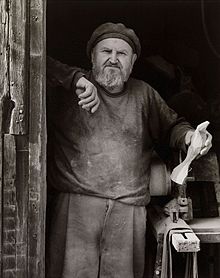Emil Milan
| Emil Milan | |
|---|---|

Emil Milan c. 1980.
|
|
| Born | May 17, 1922 Elizabeth, New Jersey |
| Died | April 5, 1985 Thompson, PA |
| Education | Art Students League of New York 1946–1951 |
| Occupation | Artist, designer, sculptor, woodworker, teacher |
| Known for | Wooden bowls, birds, art, and accessories |
| Style | Midcentury modern, biomorphism |
| Signature | |
 |
|
Emil Milan ('ɛmil Mɪ'lɑːn; May 17, 1922 – April 5, 1985) was an American woodworker known for his carved bowls, birds, and other accessories and art in wood. Trained as a sculptor at the Art Students League of New York, he designed and made wooden ware in the New York City metropolitan area, and later in rural Pennsylvania where he lived alone and used his barn as a workshop. Participating in many woodworking, craft, and design exhibits of his day, his works are in the Smithsonian American Art Museum and Renwick Gallery, the Yale Art Gallery, the Center for Art in Wood, the Museum of Art and Design, and many private collections. Once prominent in midcentury modern design, Milan slipped into obscurity after his death. His legacy has been revived by an extensive biographical research project that has led to renewed interest in his life, work, and influence.
Milan was born in Elizabeth, New Jersey and graduated from Abraham Clark High School in Roselle in 1940. He took up wood carving at an early age and learned shop skills from his father, who was an industrial welder. Attesting to his skill, one of his teachers paid him to carve a small wooden cow for her veterinarian brother.
He enlisted in the US Army in 1942, served as a Military Policeman in Europe during WWII, landing on Omaha Beach just after the invasion and advancing across France with the 1st Army. During that time, he continued occasional carving and produced provocative female figures for his fellow soldiers that he called "3D Pinups." He was honorably discharged in Monmouth, NJ on November 17, 1945.
Supported by the GI Bill, he studied art and sculpture at the Art Students League of New York starting in 1946, enrolling in classes taught by noted artists Will Barnet, Jose De Creeft, William Zorach, and John Hovannes. The sculpture courses focused on the tools and techniques of modern sculpture and on the human figure. Both de Creeft and Zorach taught then new methods of direct carving (taille directe) and both produced stylized forms, particularly of women. De Creeft also produced works in wood.
...
Wikipedia
